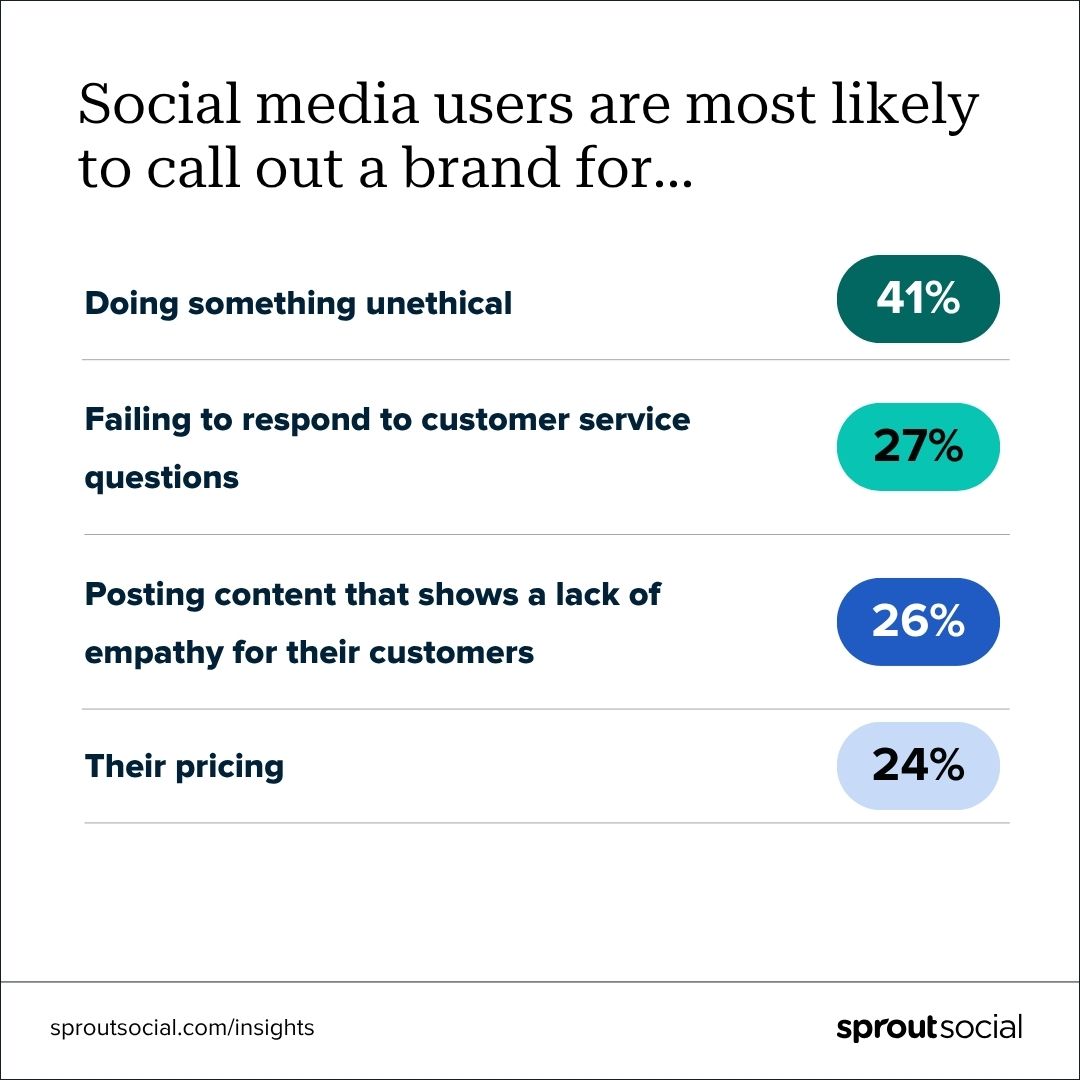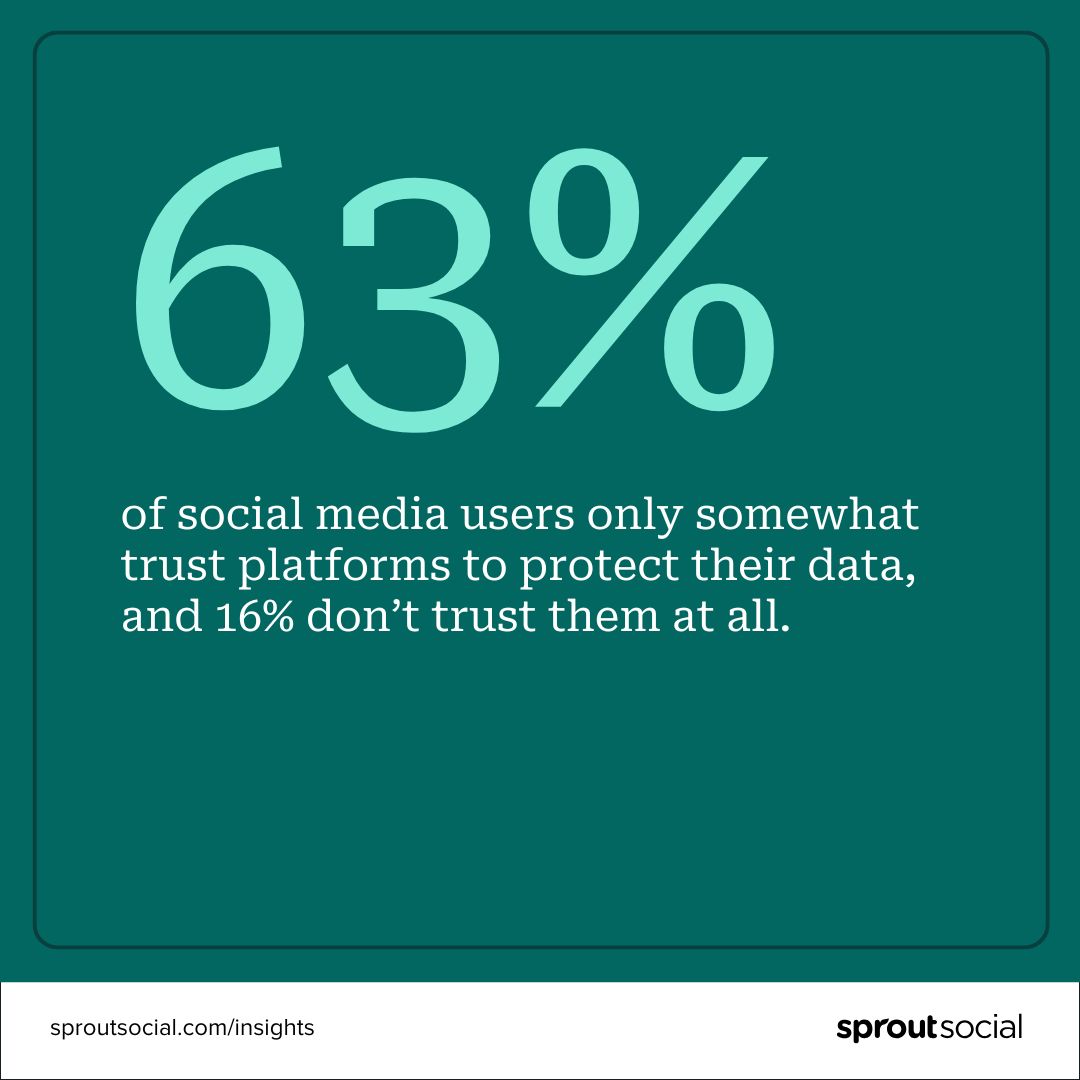Social media marketing ethics in the age of AI

Table of Contents
Is the influencer in that post actually human? That ad… was it made by AI?
These social media marketing ethics questions are popping up more often—and getting harder to answer—as generative AI works its way into nearly every corner of social media marketing, from content creation to customer service.
AI now helps brands write captions, generate images, analyze trends and even reply to comments. But as these tools become more powerful and widespread, so do the concerns surrounding AI ethics, authenticity, data privacy and audience trust.
What happens when personalization crosses the line into manipulation? What if your influencer campaign is powered more by algorithms than real people?
It’s easier than ever to move fast and scale up your social media marketing efforts. But earning trust still takes work.
In this article, we’ll explore how social media marketing ethics are evolving in the age of AI, and what’s at stake for brands that don’t keep up.
How social media marketing ethics are changing (and why brands need to pay attention)
Five years ago, social media marketing was still mostly human-led. AI tools were around, but they were more behind-the-scenes (see: chatbots and basic analytics).
Today, AI is everywhere. It generates content and influences what people see and believe online.
Before we dive into the core social media ethics pillars, let’s take a closer look at how the landscape has shifted. These changes bring new ethical considerations and implications for brands and social media marketers.
As new trends emerge, more social media ethical considerations do too
Five years ago, social media marketing ethics concerns were mostly around data privacy, fake news and influencer transparency.
- The Cambridge Analytica scandal showed how easily user data could be misused, leading to widespread distrust and stronger privacy laws like GDPR and CCPA.
- Deepfakes started going viral, raising new questions about consent and misinformation.
- UK regulators were also cracking down on influencers who failed to disclose paid partnerships.
Today, those same issues are evolving in more complex ways.
- Most generative AI models are trained on massive datasets scraped from the internet, raising questions around plagiarism and privacy.
- The line between “real” and “automated” is blurring. The challenge now is less about spotting AI and more about using it in a way that aligns with your brand and values.
- The responsibility for moderation is shifting from platforms to brands. If a campaign is biased, inaccurate or offensive, you’re still accountable. AI or influencer involvement doesn’t change that.
All these considerations mean brands need to pay closer attention to what they’re publishing and who’s reviewing it. The more automated your content becomes, the more active your social media ethics oversight needs to be.
Why it matters: The direct link between ethical practices and business outcomes
Ethical marketing isn’t just the right thing to do. It’s the smart thing to do. Your people are paying close attention to how you use AI and show up online. And the consequences for getting it wrong hit fast and hard.
According to our Q2 2025 Pulse Survey, the biggest group of social media users (41%) said they’re most likely to call a brand out for doing something unethical than for any other reason.

The impact doesn’t stop at customers. A 2025 Pew Research report found that over half of U.S. workers (52%) are worried about how AI will affect their jobs, and a third (33%) feel overwhelmed. Brands that fail to address these fears risk losing internal trust and talent.
And investors are watching, too. A 2025 report showed that AI-related lawsuits more than doubled due to “AI washing”—a growing trend where companies are using AI more as a marketing gimmick than a genuine core feature of their product.
In short, social media ethics missteps don’t just damage reputation. They impact revenue, retention and long-term brand relevance.
The core pillars of social media marketing ethics as technology evolves
You know how people love to joke that “the intern” is running a brand’s social media, when it’s typically a highly-skilled team or senior professional? The same goes for AI.
It can help streamline and scale, but it’s not ready to run the show on its own. Without oversight, even the most innovative tools—or influential creators—can publish content that’s potentially harmful or misleading.
That’s why brands need clear social media marketing ethics guardrails, which we’ll dive deeper into in the next section.
Honesty and transparency
“Honest” was the top trait social media users associated with bold brands, according to our Q2 2025 Pulse Survey, outpacing humor and even relevance. That’s no accident. When brands are open about their operations, they earn trust. And trust is the foundation of long-term loyalty.
Honesty also helps brands stay ahead of crises and misinformation. Missteps spread fast online.
But when a brand has a track record of transparency, audiences are more likely to give it the benefit of the doubt.
Take Rhode Beauty. In 2024, creator Golloria George posted a viral review criticizing the brand’s blush range for lacking shade diversity. Less than a month later, she shared that Hailey Bieber had personally reached out, sent updated products and even compensated her for “shade consulting.” Rhode was praised for how they handled the situation and acted with transparency.
Being open also protects your brand’s reputation and long-term sustainability.
Unilever is another strong example. As the company rapidly scales influencer partnerships, it’s using AI tools to generate campaign visuals. But they’ve been clear about how and why they’re doing it. This openness signals that even as they move fast, they’re doing so responsibly.
Data protection and consumer privacy
AI allows marketers to analyze massive amounts of user data to personalize content and predict behavior. But just because you can collect and act on that data doesn’t mean you always should.
According to Sprout’s Q4 2024 Pulse Survey, 63% of social media users only somewhat trust platforms to protect their data, and 16% don’t trust them at all. That trust gap should be a wake-up call.

To earn that trust, marketers must be transparent and thoughtful about how they collect and interpret data. For example, tools like social listening and sentiment analysis offer valuable insights, but they’re far from perfect. They can misread tone, sarcasm or cultural nuance, especially across diverse communities. Put too much faith in them, and you might overlook what your audience is really saying.
Protecting consumer privacy starts with transparency. Let your audience know how you’re using AI and social listening tools. Have a clear and up-to-date privacy and social media policy. Offer opt-outs for personalized content, and only collect what’s truly necessary. Most importantly, use these tools to inform, not replace, human judgment.
Spotify is a good example of both sides of this balance. Their Wrapped campaign is widely loved because it uses listener data in a fun, opt-in way that feels personal. But the brand also faced criticism for leaning heavily on generative Al in last year’s campaign.
The takeaway? People are willing to share their data, as long as brands clearly explain what they’re collecting, why they’re using it and how it adds value.
Disclosing advertisements and use of AI
Most marketers know the drill when it comes to disclosing paid partnerships.
Countries like the U.S., Canada and the U.K. have clear guidelines around sponsored content. And if influencers don’t disclose, brands can be held accountable. These rules protect consumers and brand reputation, since unclear brand partnerships can quickly backfire.
Sprout’s Q4 2024 Pulse Survey found that 59% of social users say the “#ad” label doesn’t affect their likelihood to buy. However, 25% say it makes them more likely to make a purchase. That tells us disclosure doesn’t scare people off, but it can help brands gain favor with conscious consumers.
Now that same expectation is extending to AI-generated content. A 2024 Yahoo study found that disclosing AI use in ads boosted trust by 96%.
Regulators are also taking note. In the U.S., the Federal Trade Commission (FTC) warned brands that failing to disclose AI use could be considered deceptive, especially when it misleads consumers or mimics real people. The EU’s new AI Act and Canada’s proposed Artificial Intelligence and Data Act are also pushing in this direction.
Clorox is one brand getting ahead of the curve. They’re using AI to create visuals for Hidden Valley Ranch ads, and being upfront about it. That kind of proactive transparency builds credibility in a fast-changing space.
Respect and inclusivity
Respect and inclusivity show up in the day-to-day choices brands make on social. That includes the language they use, the people they highlight, how they respond to feedback and their commitment to accessibility.
Bias often slips in subtly. Like social algorithms favoring content and creators that have historically performed well, leaving marginalized voices out. Or brands unintentionally posting content that feels tone-deaf. Like a fitness brand might assume everyone has the time, space or physical ability to work out daily. What’s meant to motivate one person can alienate another.
Inclusive brands work to catch these blind spots. They listen to feedback, design with accessibility in mind and aim to reflect a wide range of lived experiences in their content. Social media accessibility—like using alt text, captions, and high color contrast—is a big part of this effort.
Ben & Jerry’s is a strong example of values-led content. They consistently weave their stance on social issues into their content. Case in point: in June 2025, they used the “propaganda we’re not falling for” trend to call out harmful narratives they reject, like anti-abortion campaigns and greenwashing, reinforcing their long-standing commitment to inclusive activism.
How brands can stay up-to-date with guidelines and self-regulate
Social media marketing ethics are shifting fast. From evolving influencer FTC guidelines to navigating the TikTok ban to new EU governance laws, brands need to stay informed on the latest changes (and adapt accordingly).
Here are a few sources we recommend bookmarking (besides our blog, of course!):
Newsletters
- Marketing Brew: Daily news on ads, social trends and policy shifts
- Future Social: Creator and social strategy insights from strategist Jack Appleby
- ICYMI: Weekly platform, creator and social news from marketing consultant Lia Haberman
- Link In Bio: A newsletter for social media pros from social media consultant Rachel Karten
Industry news sites
- Social Media Today: Platform updates and trend analysis
- Marketing Dive and AdWeek: Coverage on influencer marketing, regulation and tech
Regulatory bodies
- FTC: U.S. advertising and influencer disclosure guidelines
- Ad Standards Canada: Ethical ad standards and influencer rules
- ASA: UK’s advertising watchdog
- EDPB: GDPR and AI use guidance across Europe
AI ethics
- Partnership on AI: A global org offering frameworks and principles for ethical AI use
Prioritize brand and social media ethics now and in the future
Ethical marketing can feel overwhelming. There’s a lot to remember: platform rules, disclosure requirements, accessibility standards, the list goes on. And if you’re trying to do everything perfectly, it can feel like walking a tightrope.
But here’s the thing: you won’t always get it right. And that’s okay.
Just keep the following things in mind:
- In an ethical grey area? Transparency is your best tool. Let people know how you’re using AI. Clearly disclose all brand partnerships. Be honest and upfront about what you’re doing and why.
- Intentions count, but so does accountability. If someone calls you out, how you respond matters just as much as what you did.
- Build social media marketing ethics into your workflows. Create checklists, write internal guidelines and loop in legal or compliance teams as needed.
- Lastly, stay curious. Tech and regulations are evolving fast. Adjust and adapt as you go by regularly auditing your tools, guidelines and processes and gathering feedback from your audience and team.
Not sure where to begin? Our Brand Safety Checklist offers practical tips on how to protect your brand from reputational threats.
Social media is constantly changing. But you don’t have to be reactive. Lead with values and set up smart systems and you’re already ahead.





Share